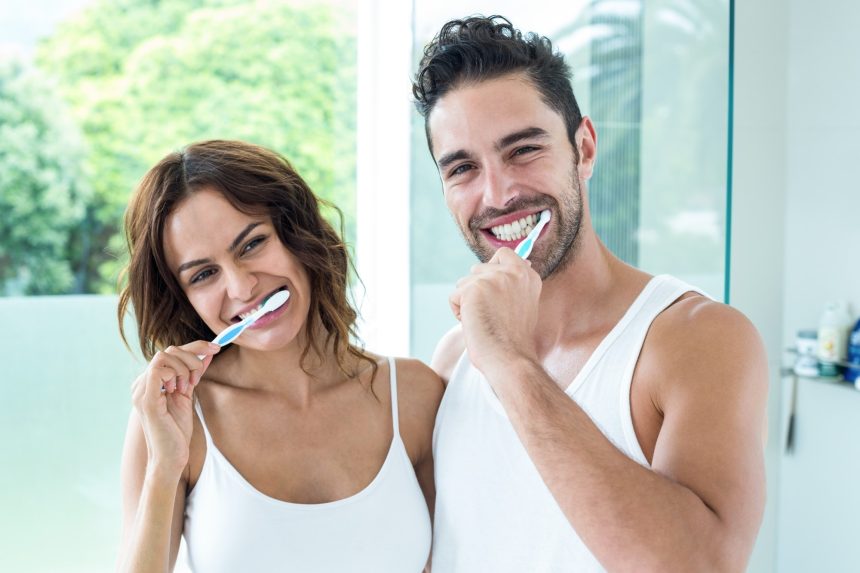Maintaining your dental hygiene is a high-maintenance job. There are many things to consider when thinking about how to keep your mouth healthy.
There are manual and electronic toothbrushes with features that vary among both kinds. Tubes of toothpaste have teeth-whitening, enamel protection, charcoal, and many other enhancements to help keep your breath fresh and promote dental health.
With so many products on the market aside from toothbrushes and toothpaste, you may wonder if you are doing enough for your dental health.
A common concern is how long should you brush your teeth. It isn’t enough to just brush your teeth – effective dental health is dependent on the length of time. Keep reading to find out the answer to this question and more.
How Long Should You Brush Your Teeth?
The American Dental Association recommends spending two minutes, twice per day, brushing your teeth. If you’re surprised to hear this, you aren’t alone. Most people brush their teeth for only 45 seconds.
Brushing your teeth shouldn’t be something quick that you do so you can check it off your to-do list. Dedicating time to brush your teeth can help remove more plaque and germs. This will contribute to better oral health and prevent diseases like gingivitis and gum disease.
The Best Time to Brush
Most people brush at some time in the morning, whether it be as soon as they wake up or after breakfast. The other common time for brushing is before bed.
If you brush your teeth after breakfast, the recommendation is to wait an hour after you eat to do so. Acidic foods like citrus weaken a tooth’s enamel. Brushing too soon after eating something acidic can remove the enamel from your teeth. For more information on how to brush your teeth, you can seek dental care by the dentist in Port Hueneme.
Brushing Technique
As silly as it may sound, there are certain techniques that are better than others when it comes to proper teeth brushing.
First, you should hold your toothbrush at about a 45-degree angle. Short brushstrokes, about the width of one tooth, are best. Use gentle pressure, along with a back-and-forth motion.
Do the same thing when you brush the section of your teeth responsible for chewing.
When you brush the back of your teeth, move your toothbrush up and down along the surface.
When you brush your tongue, move back-to-front to help get rid of bacteria that will cause bad breath.
Be sure to rinse your toothbrush when you are done, and store it in an upright position. Let your toothbrush air-dry, and avoid storing it in a closed toothbrush holder.
Finally, if you keep your toothbrush in a toothbrush holder with others, make sure that the brushes don’t touch each other.
Manual or Electric Toothbrushes?
Many advertisements claim that the best toothbrush is an electric toothbrush. For overall dental hygiene, electric toothbrushes are best.
Electric toothbrushes are better at removing gingivitis and plaque and can reach hard-to-reach places in your mouth better than most manual brushes. However, manual brushes are almost always cheaper and more portable than their counterparts.
They also do not generate any noise.
Even though electric brushes are better, the most important thing to keep in mind is how you brush your teeth and the time spent brushing. In addition, no matter what kind of toothbrush you use, the best toothbrush is a soft-bristled brush.
Hard bristles can contribute to receding gums and can damage enamel, especially if you apply more pressure than is necessary.
Once the bristles begin to bend or fray, you should replace your brush. Even if it doesn’t look like they are, a good rule of thumb is to replace your toothbrush every three to four months.
Which Toothpaste Is Best?
The main thing to look for in a toothpaste is that it has the right fluoride concentration. All the bells and whistles aside, fluoride is the most important thing when it comes to choosing a toothpaste.
The best toothpaste for adults is one that contains 1,350 parts per million fluoride. Fluoride is what helps prevent tooth decay and is essential in excellent oral hygiene.
Children do not need to use special children’s toothpaste. As long as the toothpaste they use contains between 1,350 and 1,500 parts per million fluoride, they are all set.
Children under the age of six can use a lower-strength toothpaste as long as it contains 1,000 parts per million fluoride.
For children under three, a pea-sized blob of toothpaste is sufficient.
Don’t Overbrush
The adage, “too much of a good thing” also applies to brushing your teeth. If you brush your teeth more than twice a day at longer than four minutes a session, you can wear away the enamel on your teeth.
Enamel protects the dentin layer on your teeth. Dentin contains tiny holes that access nerve endings.
Exposed nerve endings can lead to some of the most intense pain you will ever feel. Heat, cold, and even just the lightest touch against these vulnerable nerves can trigger sharp pains in your mouth.
Visit the Dentist
One of the most important things that you can do for your overall health is to visit the dentist. You should visit your dentist at least twice a year says Emergency Dentist San Diego.
They have the knowledge, training, and equipment to perform a deep clean on your teeth and to spot problems that you may have. Even if you follow all the steps in this guide, problems can still occur.
This is why it is of great importance for children to see the dentist on a regular basis, so they can develop healthy dental hygiene habits.
If you are in the Hendersonville, Tennessee area, you should check out this dental clinic for your family.
Get the Latest News
If you found this article on how long should you brush your teeth and oral hygiene helpful, check out the rest of our website. We offer the latest news in many categories, from politics, sports, health, and more.
Check out some of our other articles or sign up for notifications to stay in the loop with the latest news.














